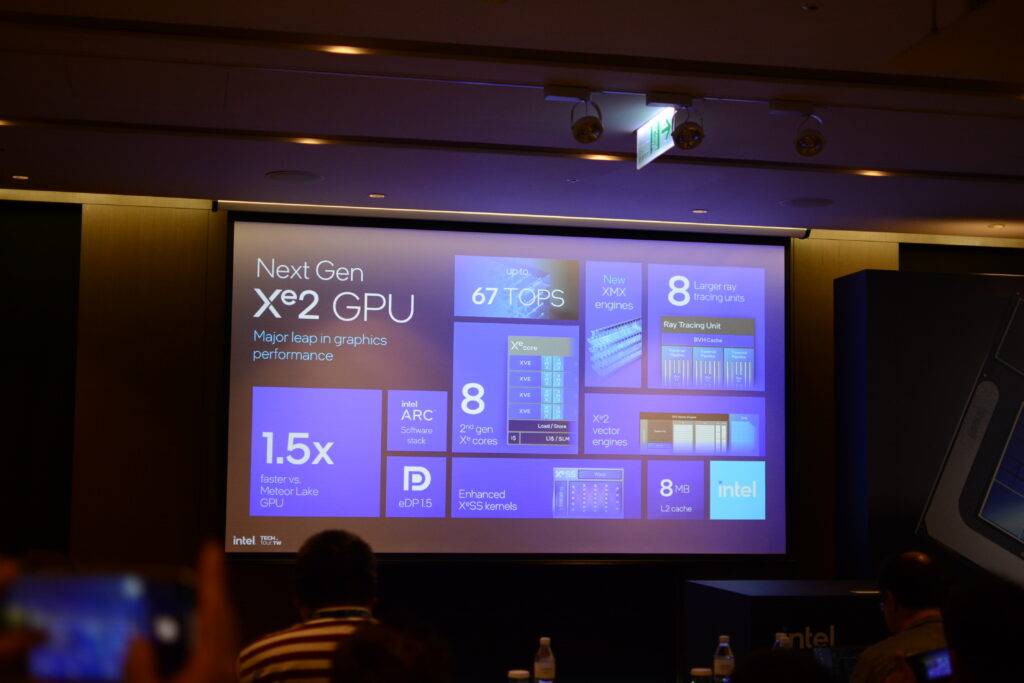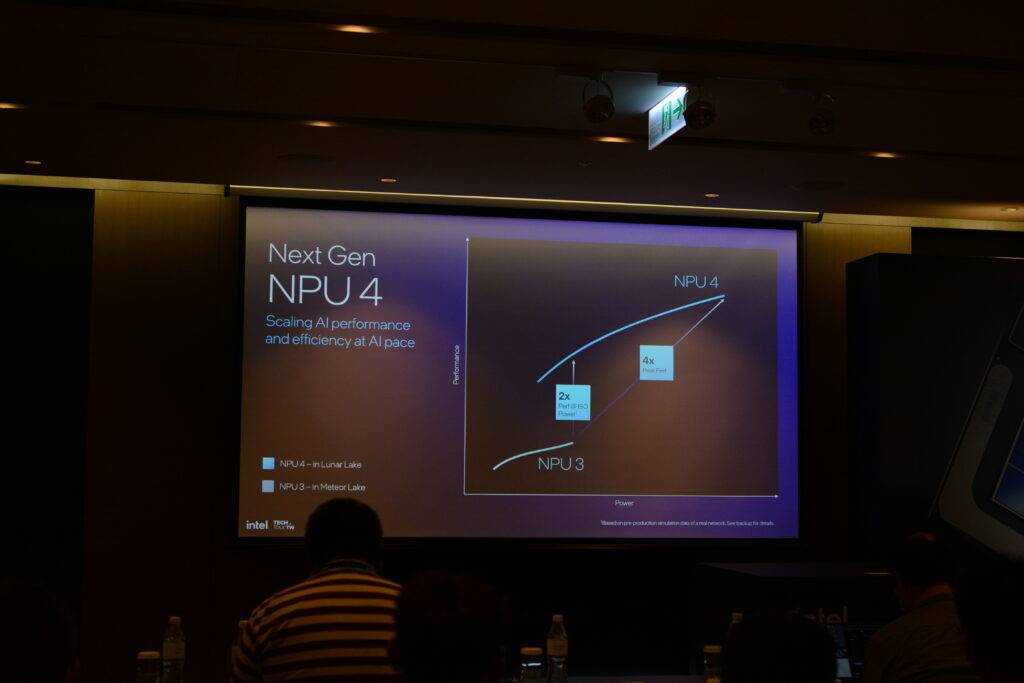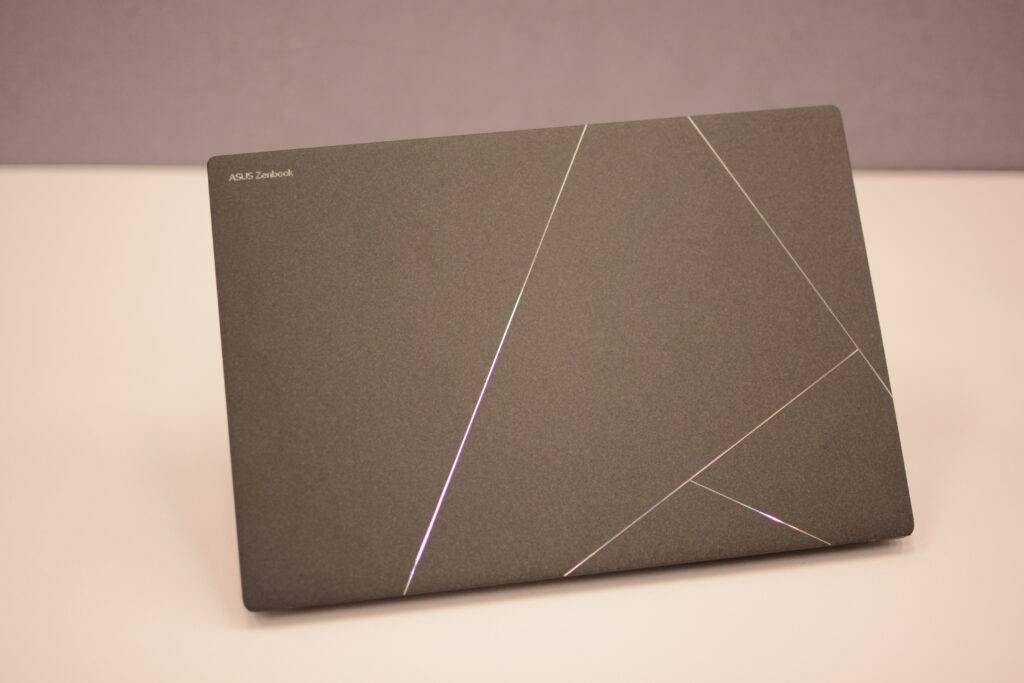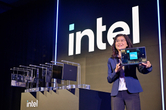
During the third edition of the Intel Tech Tour in Taiwan, Team Blue officially unveiled details of its next-gen mobile platform, Lunar Lake. Expected to hit clients and consumers later this year, the chip giant has shared in-depth information including the architecture and specifications.
Lunar Lake will be replacing Meteor Lake and Intel is touting it as its flagship SoC for the next generation of AI PCs. While the final SKUs are still under wraps, it is rumoured that the new CPUs will be advertised under the Core Ultra 2/Core Ultra 200 branding.
Disclosure: Intel sponsored my trip to Taiwan to get early access to all the announcements.
Table of Contents
Architecture overview
Lunar Lake’s microarchitecture features two distinct tiles connected through Intel’s advanced Foveros packaging technology, along with on-package memory. The Compute Tile includes the latest-generation Efficient-cores (E-cores) and Performance-cores (P-cores), both offering new microarchitecture enhancements for exceptional x86 efficiency.
The Platform Controller Tile (PCD) integrates security and connectivity features. It includes robust security components with built-in engines designed for strong system protection. The connectivity suite has been upgraded to include Wi-Fi 7.0, Bluetooth 5.4, PCIe Gen 5 and Gen 4 ports, and Thunderbolt 4 ports. The memory on package ensures rapid data access, reduces latency, and lowers the overall power consumption of the system.
According to Intel, Lunar Lake also marks a significant advancement in system-on-chip (SoC) efficiency, setting a new standard for performance and power management. The introduction of a new power delivery integrated controller, an enhanced Thread Director, memory-side cache, and improved E-core cluster collectively deliver up to 60 percent better battery life in real-world scenarios. Essentially customers can expect extended battery life, ensuring that laptops can last longer on a single charge.
Xe2 GPU
Intel has incorporated a brand new Xe2 GPU architecture for Lunar Lake along with updated media and display capabilities, supporting the latest industry standards. The new GPU is designed to deliver up to 1.5x performance improvement over the previous generation and introduces new AI capabilities.

The Xe Media Engine features an efficiency-optimized design and low-power hardware decode for the new VVC (Versatile Video Coding) codec technology. The Xe Display Engine, also efficiency-optimised, supports up to three 4K60 HDR displays with HDMI 2.1 and DisplayPort 2.1, as well as the latest eDP 1.5 standard for laptop panels.
The Xe2 GPU architecture is optimised for higher efficiency and reduced software overhead, featuring eight 2nd-gen Xe-cores, XMX AI acceleration with up to 67 TOPS (Trillion Operations Per Second), and eight enhanced Ray Tracing Units. Platform and software optimisation leverage Arc’s software stack, including XeSS AI-based upscaling with new optimised kernels.
NPU
There are significant updates to the NPU (Neural Processing Unit), which Intel states are critical for addressing three growing trends in AI compute in client devices: the increasing diversity in AI workloads, the rise in app and OS integration, and the emergence of multimodal AI PCs. As AI compute requirements surge, matching compute capabilities with power efficiency on devices becomes essential.

Lunar Lake comes with NPU 4, built on the same foundation from three prior generations, offering higher compute capacity and increased efficiency to support an array of use cases and ensure all-day battery life. Compared to its predecessor, NPU 4 increases the number of engines, enhances clock speeds, and incorporates multiple architectural improvements to boost performance and efficiency.
Notable enhancements include significant improvements to the frequency and voltage curve through pipeline optimization, targeted V/F optimization, and ML/AI techniques, achieving up to 20 percent power reduction beyond process and design improvements. While NPU 3 supported 11.5 TOPs, NPU 4 supports up to 48 TOPs, offering twice the DMA bandwidth for improved network performance, especially for large language models (LLMs), and features specialised matrix and vector engines, an inference pipeline with MAC arrays, fixed function blocks, and programmable DSPs.
Connectivity
When it comes to connectivity, the new Lunar Lake platform will be the first Intel platform with Wi-Fi 7 integration. This significantly enhances wireless collaboration, seamless multi-device control, immersive AR/VR experiences, and high-speed wired peripherals.
Wi-Fi 7 is expected to offer up to 5x faster speeds and 60 percent lower latency, premium multi-link operation, AI-based proximity detection for Wi-Fi sensing, and platform-level optimizations such as optimized DDR memory clock frequency adaptation based on Wi-Fi channel usage.
Bluetooth over PCIe reduces boot and wake-up times by about 55 percent, while Intel Unison supports tablets with extended screens, universal control, and concurrent connection abilities. It also optimizes connectivity through intelligent use of all available technologies, Swift Connect for file sharing with non-Unison devices, and provides a universal hotspot for phone-PC and multi-device experiences across any OS.
The Intel Connectivity Performance Suite will offer AI-based traffic prioritisation and air interface management, HMD-PC onboarding, single radio AR/VR experiences, enhanced access point scoring, and IT controls for priorities, bandwidth, and key configurations. Intel Killer Networking introduces a user interface redesign and AI overclocking integration. Intel Connectivity Analytics offers data and insights about the PC and its vicinity for improved network management, support, and services, with an SDK available for partners.
Thunderbolt will offer up to 25 percent higher bandwidth with Thunderbolt 5 SSDs, as well as Thunderbolt Share capabilities. Thunderbolt Share enables PC-to-PC access for sharing screens, monitors, keyboards, mice, and storage, folder syncing, and drag-and-drop file transfers between PCs at super fast transfer speeds. It also facilitates data and file transfer between old and new devices, offers a super-fast connection with high bandwidth and ultra-low latency, commercial-ready hardware-based security, and licensing for new Thunderbolt accessories or PCs that work with all Thunderbolt 4 or 5 products on Windows OS.
Intel said that Lunar Lake will support up to three ports with two recommended as a baseline, up to 40Gbps wired speed, support for up to three 4K/60Hz monitors, and ultra-low latency devices.
Security
As devices shift to AI, security becomes paramount, and building an ecosystem to secure both users and models is critical. To address that, Intel has taken measures to improve security with Lunar Lake by providing protection across hardware, firmware, and software through hardware-based capabilities. This approach apparently ensures the security of user data through hardware-software co-functioning while developing fast and power-efficient systems with built-in security. Intel’s holistic approach to platform security includes advanced threat protection, application and data protection, and below-the-OS security.
Advanced threat protections eliminate classes of attacks and detect new ransomware and crypto-jacking threats using AI-based silicon security through GPU-accelerated memory scanning and CPU-based telemetry with machine learning. Application and data protections guard against traditional malware attacks targeting applications, login credentials, and data, with Intel VT-redirect protecting kernel memory from adversary writes to kernel page tables. Below-the-OS security provides protection through security engines and prevents firmware attacks, with the Intel Partner Security Engine (IPSE) on Lunar Lake SOC offering partners the flexibility to run their applications securely with complete isolation from the rest of the SOC and resources.
Final thoughts
The new Lunar Lake platform is a substantial jump from Meteor Lake and could overall offer a far more cohesive experience. Expect formidable gains in terms of compute as well as AI performance, alongside improved battery life and overall efficiency. The mobile PCs powered by Lunar Lake will be available by the end of Q3 2024.
Intel and ASUS gave us an early look at the first set of laptops including the ZenBook S14 and the ExpertBook P5, powered by its new platform. While they look impressive on paper, there’s a lot left to be explored.

For instance, there is no concrete information around the final SKUs nor do we have any performance numbers. It will be interesting to see how Lunar Lake fairs against Qualcomm’s new Snapdragon X Elite and the newly launched AMD AI 300 mobile chips.

















